Trees, Shrubs and Woody Vines
Media

Species Types
Scientific Name
Symphoricarpos orbiculatus
Description
Buckbrush, or coralberry, grows throughout Missouri. This familiar thicket-forming shrub bears dense clusters of pinkish-red berries that persist through most of the winter.
Media
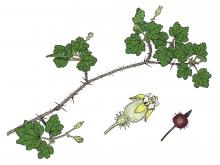
Species Types
Scientific Name
Ribes cynosbati
Description
Prickly gooseberry occurs mostly in the eastern half of Missouri. Its spine-covered berries turn reddish purple when ripe. Despite the prickles, they are edible.
Media
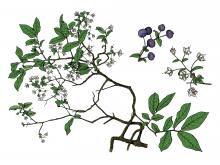
Species Types
Scientific Name
Vaccinium stamineum
Description
Deerberry is an irregularly branched shrub, rarely more than 6 feet high. A blueberry relative, it bears edible blue fruits.
Media

Species Types
Scientific Name
Vaccinium arboreum
Description
Farkleberry, or sparkleberry, is a stiff-branched shrub or small crooked tree growing in loose thickets on rocky soils, mostly south of the Missouri River. A type of blueberry, its black fruits are edible but dry and mealy.
Media
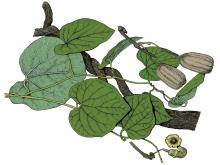
Species Types
Scientific Name
Aristolochia tomentosa
Description
Woolly pipe-vine is a high-climbing woody vine common along streams in the Ozarks. Hikers and canoeists often don’t notice it because the leaves and unusual flowers are usually high overhead in the trees.
Media

Species Types
Scientific Name
Cocculus carolinus
Description
Carolina moonseed is a slender, twining vine. It is scattered in southern and eastern Missouri. It bears clusters of bright red, somewhat flattened fruits. The disk-shaped seeds are spiraled like a snail shell.
Media
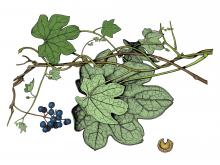
Species Types
Scientific Name
Menispermum canadense
Description
Common moonseed is a rather slender, twining vine that climbs or sprawls. It occurs nearly statewide. It bears clusters of bluish-black fruits. The seeds are flattened, with a raised edge shaped like a crescent moon.
Media

Species Types
Scientific Name
Calycocarpum lyonii
Description
Cupseed is a relatively stout, robust twining vine that dies back to the ground in severe winters. It is scattered south of the Missouri River. It bears clusters of black fruits. The seeds are shaped like little cups.
Media

Species Types
Scientific Name
Callicarpa americana
Description
American beautyberry is a many-branched shrub that bears attractive rounded clusters of purple berrylike fruits in the axils of the leaves in late summer and fall. A critically imperiled species in Missouri, it is also a popular native shrub for landscaping.
Media
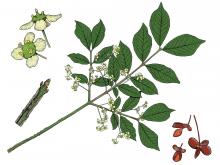
Species Types
Scientific Name
Euonymus alatus
Description
Burning bush, or winged euonymus, is a nonnative shrub that has been very popular in landscaping for its bright red fall foliage. But it is invasive and spreads aggressively into natural habitats, displacing native species.
See Also
About Trees, Shrubs and Woody Vines in Missouri
There are no sharp dividing lines between trees, shrubs, and woody vines, or even between woody and nonwoody plants. “Wood” is a type of tissue made of cellulose and lignin that many plants develop as they mature — whether they are “woody” or not. Trees are woody plants over 13 feet tall with a single trunk. Shrubs are less than 13 feet tall, with multiple stems. Vines require support or else sprawl over the ground.





















